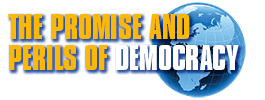This is an exceptionally tumultuous year. As the pandemic has made injustices more visible and brought important issues to the surface, activists, politicians, and other segments of the public have responded broadly and created a new momentum for change.
To support this momentum, the Stone Center on Socio-Economic Inequality at The Graduate Center, CUNY, and The Graduate Center’s Office of Public Programs, through its Promise and Perils of Democracy project, funded in part by Carnegie Corporation of New York, organized a three-part Coalitional Democracy Conference, which took place on October 2, 2020. It featured the voices of academics, activists, politicians, journalists, and clerics on the how-to of democratic change at this crucial moment in history. They passionately discussed the theory and practice of coalition formation for advocacy organizations, political parties, and social movements. Here we present you with the highlights of Panel 3 of the conference, which you can view below.
Panel 3: Coalitions and Social Movements
Ruth Milkman, professor of sociology at The Graduate Center and at the School of Labor and Urban Studies, CUNY, moderated the third and final panel of the Coalitional Democracy Conference. In her opening remarks she traced the transformation of the labor movement from a sometimes conservative, domineering, or solitary actor to one that came to include groups previously seen as threats, such as immigrants and environmental organizations, or the blue-green alliance. This shift was partly a function of diminishing power and resources, which created the need for coalitional partners. The panelists addressed the limitations and evolution of other social movements, the constraints of the two-party system on the achievement of popular coalitional movement demands, and social movement strategies that have been successful and responsive to this unique historical moment.
Political Science Professor Daniel Schlozman from Johns Hopkins University began by outlining structural limitations on achieving popular social movement demands in the U.S. context. Majoritarian politics impose harsh limits on left-leaning parties and movements because the voting electorate and other electoral institutions, such as the Electoral College, are more conservative than eligible voters. A broader geographic base beyond urban areas where left and moderate movements have done best is therefore required. Further, the different concerns in local politics and national politics (housing, for example), make it harder to build coalitions around a core agenda. Tensions also arise internally as all movements contain both radicals and pragmatists. Successful movements are those in which leaders and members understand this tendency and tailor their tactics to suit the strengths of both types of actors. The hardest problem, finally, is to build coalitions across movements or issue priorities. The process of deciding which issues come first or what compromises should be made puts a strain on cross-movement solidarity.
Kelley Robinson is vice president of advocacy and activism and executive director of the Action Fund at Planned Parenthood Federation of America. Robinson began by highlighting how, in early 2017, Planned Parenthood was part of a broad coalition of organizations that mobilized to oppose the incoming Trump administration’s attack on the Affordable Care Act (ACA) and Planned Parenthood, as well as on immigration, and the movement largely prevailed. Despite the real constraints on coalition formation and influence mentioned by other panelists, Robinson described how coalition-building was actually easier in early 2017 compared to prior years because there was a common, potent threat to mobilize against. Organizations and issue groups of many kinds, such as labor, climate change, and LGBTQ rights, came together and continued to grow, making coordinated responses to subsequent threats timelier and more effective. Robinson stressed that the intersectional nature of the coalitions that Planned Parenthood has been involved in — the strategic decision to be, as she put it, all in together — was essential to their success and ongoing impact, including later in 2017 when the #MeToo movement surged.

Panelists (left to right): Ruth Milkman, Daniel Schlozman, Hahrie Han; (bottom:) Kelley Robinson, Reverend Liz Theoharis
Political Science Professor Hahrie Han, who directs the P3 Lab at Johns Hopkins University, discussed the factors that allow social movements to exercise influence and power. Han argued that as government becomes less responsive to public preferences, social movements become more necessary as a form of political expression. But most social movements do not gain enough power to break through and create change. Such success, she argued, requires the formation of broad coalitions. Her research suggests that solidarity and thus political power peaks when governance structures are created that involve equal exchanges of resources and interests among coalition partners. She also found that successful movements are embedded within dynamic “ecosystems” of interconnected experts, such as lawyers and legislators, and organizations with resources, such as funders. One example is the coalition against anti-immigrant legislation in Arizona, which began in 2010 in response to the state’s Senate Bill 1070 and is considered partially responsible for the increased support for Democratic candidates that we are seeing today.
The Reverend Dr. Liz Theoharis, co-chair of the Poor People’s Campaign and director of the Kairos Center for Religions, Rights, and Social Justice at Union Theological Seminary, concluded the conference. Multi-issue organizing is at the core of the Poor People’s Campaign because many different kinds of injustice are interconnected in the lives of poor and low-income individuals. People without homes, for instance, are also often in need of medical care. It is nearly impossible to solve one problem without solving the other. Moreover, these problems have deepened, become more interconnected, and affected more people, while, at the same time, current economic and political leaders and institutions are failing to address them. Specifically, the Poor People’s Campaign seeks to address the following five interlocking injustices: systemic racism, poverty, ecological devastation, militarism and the war economy, and distorted narratives of religious nationalism. When organizing people across these issue dimensions, the campaign emphasizes the need to build coalitions from the bottom up, as the most powerful leaders are those most affected by injustice. We conclude with her powerful call to action:
“Bring in faith communities […], bring in labor unions […], bring in other organizations where folks are working on these issues in their silos but also agree that we have to come together and fight that all out. And that you need to build an infrastructure that lasts, but from the ground up. A national movement isn’t national because it has a P.O. box in Washington, but because folks in local communities are building power. And that needs to involve fighting on the streets, fighting in the courts, fighting in the legislature, having a new form of music and culture, having lawyers that are doing radical lawyering, carpenters, painters and engineers coming up with what this new society can be. This all happens at the same time. …
This is not a time for incremental change. This is not a time for small and narrow policies. This is a time where we want it all, and we want it all now.“
For Panel 1 and Panel 2 go here and here. These and other videos are also available to view on The Graduate Center, CUNY’s YouTube channel.
